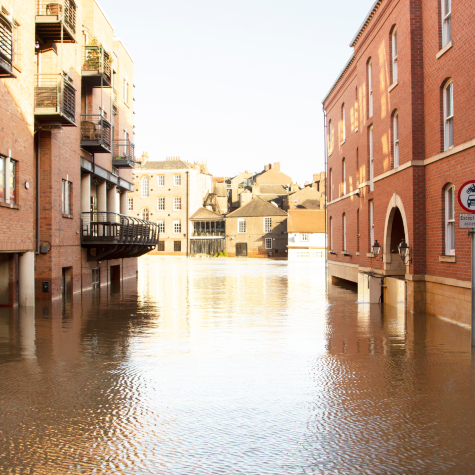
Introduction
Climate change is no longer a threat but an active force to be reckoned with. In 2021, Europe witnessed catastrophic floods across ten countries including Germany and the UK, while 2023 brought the worst floods in over a century to northern Italy and wildfires to Spain, Portugal, and France.
Despite warnings about global warming dominating headlines for decades, the urgency is now palpable. Global warming moves ever closer to the 1.5-degree mark, agreed by climate experts to be the critical limit. Amidst media discourse on this climate crisis and its effect on wildlife, agriculture, and weather systems lies a more immediate area of concern: our homes.
Climate change, and the floods and wildfires it causes, pose a significant unknown when it comes to the property market. According to a recent McKinsey report, the effect on real estate is already significant, with a 40% drop expected in returns for diversified equity portfolios within the decade. With extreme weather events and rising sea levels affecting new areas of the world every year, the perils of climate emergency now resonate through valuations, decision-making processes, and investment strategies.
As homeowners, investors and property professionals navigate the turbulent waters of climate change, the big question is how much the shifting ecosystem will affect property prices. Read on to learn more about the ripple effect of climate change on property values, as well as strategies for a future where the market is as unpredictable as the climate itself.
The Climate Connection
We’ve long been aware of the scientific foundation for climate change, yet its tangible impact on land and buildings has only recently become evident. Climate change not only increases the risk of physical damage to buildings through extreme weather, rising sea levels and natural disasters. It also implicates housing in the global CO2 emissions equation, creating a symbiotic relationship between climate change and housing, and presenting risks in both directions.
In the UK, the signs of climate emergency are undeniable – we have experienced wetter winters, drier summers, and record-breaking temperatures. Our housing stock is unprepared for these eventualities, with homeowners and tenants overheating in the summer and falling prey to flooding in the winter.
As physical risks to UK property escalate in scale and frequency, the prospect of “stranded assets” looms large. These are properties that are rendered difficult to mortgage or insure, gradually depreciating in value, and eventually posing a risk to their inhabitants. More and more UK properties are gaining this status as their structural integrity and suitability for habitation are threatened by rising tides or extreme weather.
Climate change-related issues also elevate property insurance premiums in vulnerable areas, with insurers reassessing their products to incorporate the uncertainties of climate risk. As a result, the annual fluctuations in premiums are likely to alter investor preferences for both property types and locations.
Meanwhile, the increasing public awareness of climate change and government regulations put in place to stall it are changing investors’ priorities when it comes to acquiring new properties. With a UK-wide commitment to net zero building methods by 2050, consumer expectations are changing, ushering in a new wave of green homes. In navigating this evolving landscape, real estate professionals stand to create new opportunities while moving toward a more climate-conscious future.
Warming and Cooling
The annual uptick in global temperatures means more than just erratic weather patterns. The UK’s buildings are bearing the brunt of both hotter summers and colder winters. As most UK building stock lacks HVAC (heating, ventilation and air conditioning) systems designed for such climatic shifts, this poses a unique and urgent challenge.
Global warming means more than just heat, though. The environmental upheaval caused by the climate crisis has also resulted in severe winters with strong winds and rains, and intense snowstorms across the UK. This means that when homeowners and tenants aren’t powering fans, they’re turning on their heaters.
As homeowners and tenants become reliant on electricity to power fans, heaters and dehumidifiers, they shoulder heightened utility costs to maintain a safe and healthy living environment. These costs can swiftly become untenable during a cost-of-living crisis. On a wider front, the increased use of these appliances causes greater strain on the electrical grid and municipal resources, as well as increased carbon emissions, further adding to the climate crisis.
It’s no wonder that thermal comfort has become a priority for prospective homeowners, tenants and investors. Whether they’re seeking older properties renovated with modern insulation and heating systems, or newer structures ensconced in energy-efficient designs, the preference is clear. This rising need will alter the investment landscape, encouraging developers to install energy-efficient thermal solutions rather than see their properties decrease in value.
Extreme Weather Events
The surge in extreme weather events fueled by global warming casts uncertainty over property values worldwide. Here in the UK, we have felt the effect of severe storms causing peril in coastal areas and cutting off rural locations. We’re also seeing an increased amplification of historical threats such as river flooding due to climate change.
We can look to the more extreme conditions in the USA as a template for what could come, where multiple hurricanes a year cause up to $220 billion in damages. Simultaneously, wildfires have burgeoned in intensity and frequency. Larger, more destructive fires have destroyed millions of acres, decimating real estate values. Repair bills and insurance premiums skyrocket, and neighbouring areas see escalating property prices and rents as residents are forced out of their homes and neighbourhoods.
The regions most commonly affected by these storms have built up protective measures against them, both in terms of individual dwellings and entire communities. Every dollar invested in protective measures is a prudent wager, potentially saving five times that amount in future damage mitigation. However, even seemingly resilient properties can face a devaluation spiral. An investor may fortify a building against extreme weather, but if access roads are regularly cut off by floods or fallen trees, the value of that property will still go down.
It is also worth considering how a natural disaster can affect the demand in the larger area. After a flood or a wildfire, potential homebuyers or tenants may consider an area too unsafe to move into. The fallout of the disaster may take many years to recover from, leaving the area difficult to access and aesthetically unappealing. Furthermore, the damages incurred by businesses in the area are likely to lead to the loss of jobs and income, reducing the amount that can be spent on rent and mortgages.
With studies in the US showing a 5% to 13% drop in property prices in areas adjacent to wildfire damage and European real estate prices decreasing by 4% to 45% contingent on flood exposure, even proximity to a natural disaster can decrease demand and property value in an area.
Obtaining approval for mortgages in climate-exposed areas may also become more arduous, given the elevated risks and the scarcity of insurance coverage. This means that even where homebuyers are willing to accept the risk of natural disasters, they may be financially unable to do so.
This turbulence is sending ripples through the property market. Properties once perceived as secure investments are now at risk of devaluation. On the plus side, regions proactively defending against climate change effects are starting to attract discerning investors, and are witnessing a surge in value.
Sea-Level Rise
The gradual yet grinding rise in sea levels casts a shadow over coastal properties, with current predictions suggesting that by 2050, 800 million people could face danger from a 0.5m rise. In the UK alone, the trajectory of global warming places 1.5 million properties at risk from rising sea levels by 2085.
Coastal properties have historically enjoyed high demand and escalating prices, especially in the aftermath of the Covid lockdowns, when Londoners flocked to the seaside towns of Sussex and Kent for a change of lifestyle. However, this could be altered by the increasing danger of sea storms and flooding as the tide of climate change rises.
As flooding risks intensify, so do insurance premiums, reaching a point where some insurers are considering withdrawing flood coverage altogether. If homeowners can’t insure against the rising threat of flood damage, relocation is a pragmatic choice – particularly when pitched against the annual cost of repairs.
Beyond concerns about damage, seaside properties are facing a shift in demand dynamics. As climate-conscious millennials step onto the housing ladder in greater numbers, the allure of seaside living may be overshadowed by more eco-friendly and climate-resilient choices. Meanwhile, as climate change reshapes the UK’s coastlines and high tides become higher, the picturesque beaches and harbours that drew so many to coastal living may start looking very different. And what good is a beach destination without a beach?
Adaptation and Mitigation
Where climate change was once a peripheral consideration for the housing market, it has now surged to the forefront. With the UK government’s commitment to net zero by 2050, new regulations are coming into play to promote greener development. This affects all areas of the real estate market, from investors to local authorities to insurers and lenders.
Adapting to these regulations means proactively understanding and incorporating eco-friendly practices into the financial and risk management aspects of real estate. As a result, eco-conscious communication to potential homebuyers will intensify, emphasising the potential impact of climate risks on homes and promoting strategies to prevent or mitigate damage.
Property owners are being urged to adopt proactive strategies, emphasising cost-effective preventative retrofitting measures such as flood prevention enhancements, insulation and eco-friendly HVAC solutions.
We may also see adaptation on a city-wide basis, mirroring successful models like Amsterdam’s flood mitigation systems. These measures can safeguard habitable dry land, making cities and districts that employ them more desirable areas for property investment.
Mitigating climate change burdens requires a paradigm shift towards green practices across the real estate industry. This encompasses smarter consumption, reduced carbon footprints, and selecting environmentally friendly construction materials. By focusing on energy-efficient buildings, embracing fire-resistant and flood-proof materials, and optimising energy use, the industry can create properties designed to thrive in the face of climate challenges.
Conclusion
As we approach the net zero deadline of 2050, the increasing effects of climate change and the imperative to decarbonise will necessitate revaluing and future-proofing both homes and investment portfolios.
While the exact impact of climate change on property prices remains as uncertain as the weather, some aspects can be predicted: buying and selling properties in areas at high risk of flood or fire may lead to diminished profits. Previously desirable properties such as coastal homes are likely to decrease in value, in favour of homes with modern climate resilience measures built-in or retrofitted.
Climate-centric regulations and adaptation measures will undoubtedly play crucial roles in shifting property values, as will the growing public understanding of climate change, extreme weather risk and sustainability. This education and mitigation can go a long way to both protect existing investments and create a new generation of climate-resilient housing stock.
Change is not just coming – it’s already here. Recognising this, investors, developers, and real estate professionals must work to embrace sustainable practices, decrease carbon emissions, and seize opportunities for value creation in an ever-shifting landscape.

